Retractable leashes, while they may seem convenient and fun, aren’t always the best option for your furry friend. These leashes might give your pup a feeling of freedom, but they also come with some unexpected downsides. In fact, many dog owners don’t know about the potential issues these retractable leashes can cause down the road.
From safety concerns to training setbacks, there are quite a few reasons to avoid a retractable leash for your dog, and many pet experts recommend reconsidering using them. Want to know more? Read on as we go into the details, presenting key reasons to steer clear of these tempting pet accessories.
Key Takeaways
- Retractable leashes don’t give you the necessary control over your animal. The leash can get tangled and break, and the long leashes reinforce pulling.
- Some municipalities may even outlaw long retractable leashes.
- There are several sturdy leash alternatives, such as leather, biothane, rope, and nylon leashes.
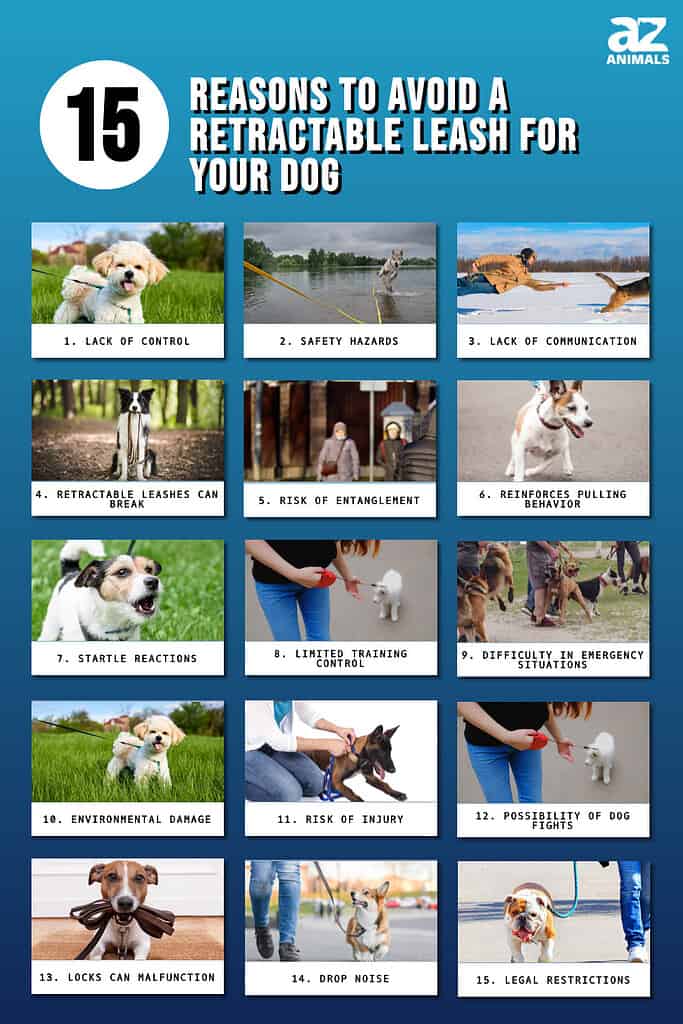
1. Lack Of Control

You can easily lose control of your pet on a retractable leash.
©iStock.com/marketlan
Retractable leashes may seem like a convenient option for your furry friend. They give your dog a bit of extra freedom to explore on walks. But, one important reason to reconsider them as an option is due to the lack of control.
Imagine you’re out for a stroll, and suddenly a squirrel dashes across your path. In a split second, your dog is off, the retractable leash unwinding rapidly. You’re left scrambling to reel them back in. This lack of immediate control can lead to risky situations, potentially placing your pet in harm’s way. The long cord of a retractable leash makes it harder to keep your dog close in busy or dangerous areas, such as streets with heavy traffic or parks with other animals.
Thus, while retractable leashes may promise freedom, they might actually compromise safety. So, keeping your pet on a shorter leash literally means better control and less worry.
2. Safety Hazards

Untangling a twisted retractable leash can be frustrating and time-consuming, and it could also risk injury to you or your pet.
©Holger Kirk/Shutterstock.com
These leashes may seem convenient, but they come with safety hazards that can put both you and your furry companion at risk.
One major concern is the thin cord or tape used in these leashes. This material, while allowing for extension and retraction, can pose dangers if it becomes tangled around you or your dog. We are talking about cuts, burns, or other injuries that may occur if the cord wraps tightly around a limb or gets entangled in your dog’s fur.
These safety hazards can be especially concerning in crowded or busy areas where there’s a higher chance of the leash getting tangled with people, objects, or other dogs. Untangling a twisted retractable leash can be frustrating and time-consuming, and it could also risk injury to you or your pet.
3. Lack Of Communication

It may be harder to train and community with your dog when using a retractable leash.
©Alexander_Evgenyevich/Shutterstock.com
Many dog owners are not aware that a retractable leash can hinder effective communication with their dogs, which is vital for a positive walking experience. The constant tension on the leash creates challenges in conveying commands clearly, resulting in confusion and potential behavioral issues.
When your dog is on a retractable leash, the variable tension makes it harder for them to interpret your cues and signals. This inconsistency can lead to mixed messages, causing frustration for both you and your pet. It becomes difficult for your dog to understand when to slow down, stop, or change direction, as the tension on the leash may not align with your intended instructions.
Clear communication is also essential for reinforcing good behavior and training your dog.
4. Retractable Leashes Can Break

There are potential dangers if your dog breaks free near a busy road or in an unfamiliar environment.
©xkunclova/Shutterstock.com
Retractable leashes may not be able to withstand the force of a strong dog, particularly when they lunge or pull suddenly. The thin cord in these leashes is susceptible to breaking, especially if a powerful dog takes off at full speed. When the cord snaps, it can have serious consequences. Your dog can escape and run off, putting themselves in harm’s way or causing accidents.
Additionally, there are potential dangers if your dog breaks free near a busy road or in an unfamiliar environment. It can be difficult to regain control and ensure their safety once the leash has broken.
To prevent such incidents, we always recommend choosing a sturdier leash that can withstand the strength of your dog and provide reliable control, especially if you have a large energetic pup.
5. Risk of Entanglement

The thin cord of retractable leashes can easily get tangled around you or others.
©Oleg Elkov/Shutterstock.com
Another reason to avoid a retractable leash for your dog is that these leashes come with the risk of entanglement, which can be hazardous for both your dog and those around you. The extended length of the leash increases the chances of your dog getting tangled with other people, other dogs, or objects during walks. This could lead to another person or dog tripping and getting injured.
When your dog approaches another dog, the retractable leash can be wrapped around their legs or bodies, leading to a potential confrontation or injury. Likewise, if the leash gets entangled with people passing by, it can cause accidents or discomfort for everyone involved.
The freedom to roam offered by a retractable leash may seem appealing, but it’s essential to consider the potential risks that these leashes could create.
6. Reinforces Pulling Behavior
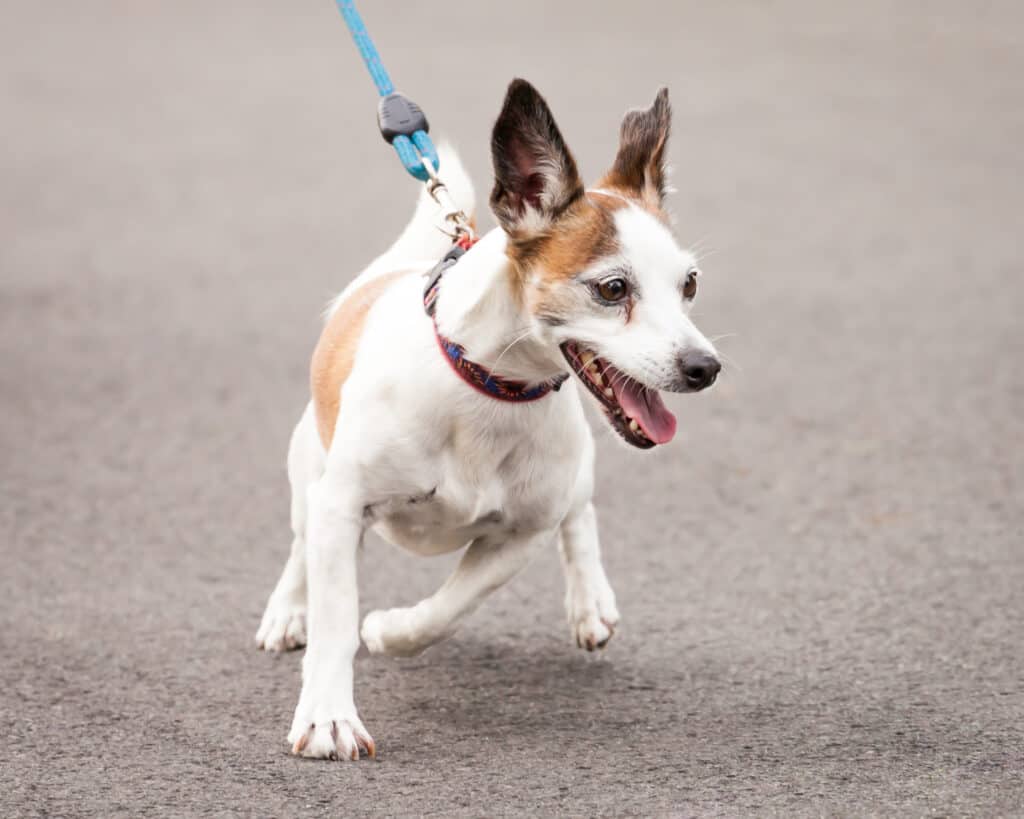
Dogs quickly learn that by pulling, they can extend the leash and gain more freedom to explore.
©iStock.com/sjallenphotography
When dogs associate pulling with increased freedom, it becomes a difficult habit to break. The constant tension on a retractable leash encourages them to pull continuously as they learn that pulling gets them what they want. This can lead to a frustrating and unenjoyable walking experience for you.
Using a retractable leash can inadvertently reinforce pulling behavior in dogs. Dogs quickly learn that by pulling, they can extend the leash and gain more freedom to explore.
7. Startle Reactions

The sudden retraction of the leash can startle your furry companion, triggering fear or anxiety.
©alexei_tm/Shutterstock.com
Dogs rely on consistency and predictability to feel secure during walks. A retractable leash’s quick and unexpected retracting motion can disrupt their sense of safety and cause them to react defensively. This can make your walks stressful and create a negative association with the leash itself.
Retractable leashes have a potential drawback when it comes to startling reactions in dogs. The sudden retraction of the leash can startle your furry companion, triggering fear or anxiety. This startling experience can lead to reactive behaviors, such as barking, lunging, or even aggression, as a response to the unexpected movements of the leash.
8. Limited Training Control
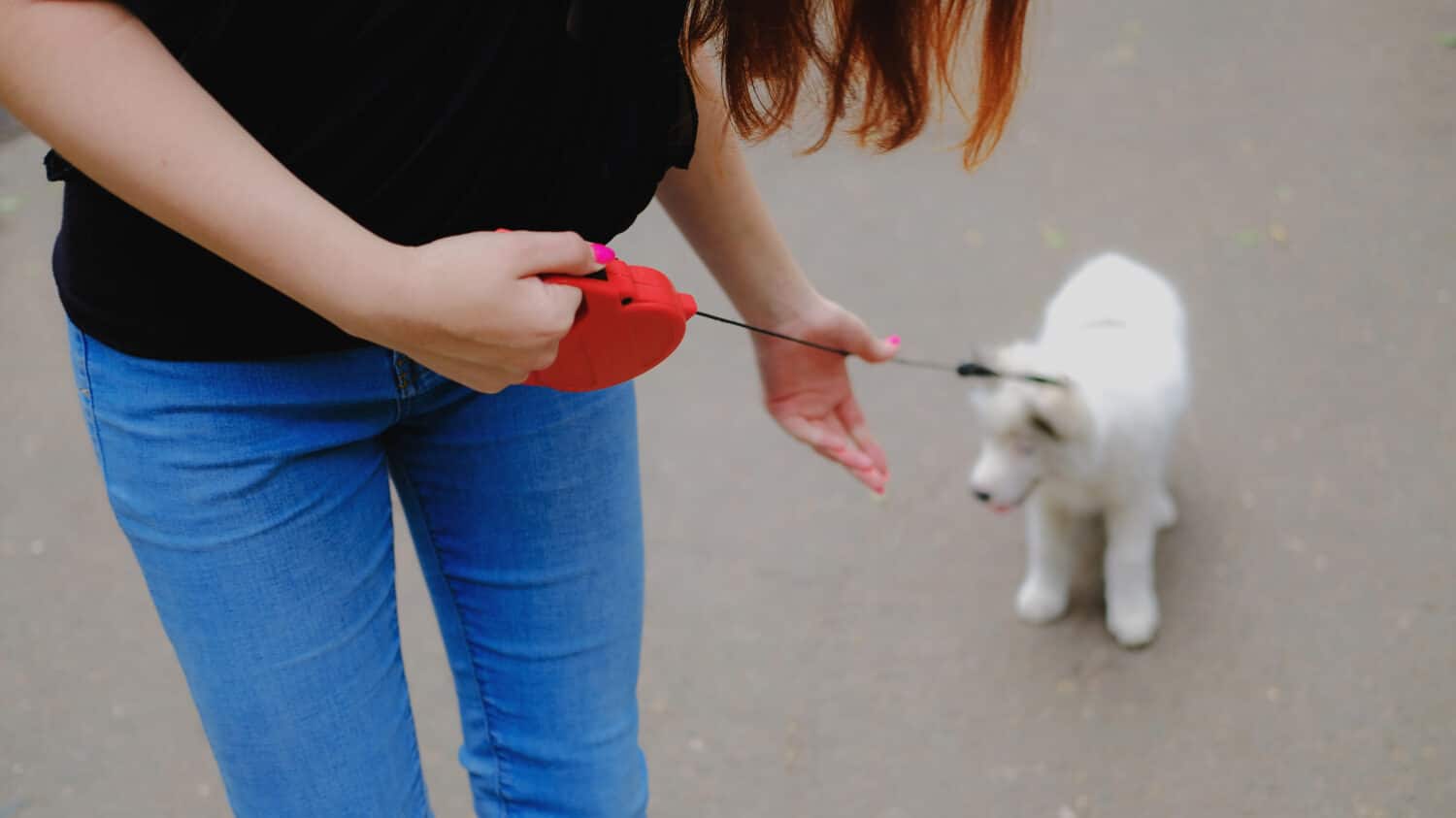
Retractable leashes have too many variables to allow for the proper training of dogs.
©Yolya Ilyasova/Shutterstock.com
With a retractable leash, the varying tension and length of the leash can undermine your ability to provide consistent cues and feedback. It becomes difficult for your pet to retain its attention on you, hindering its understanding of desired behaviors. Inconsistent control can confuse your dog and make it harder for them to learn and respond appropriately.
Retractable leashes can also pose limitations when it comes to training your dog effectively. Training requires consistent control and guidance, but retractable leashes offer limited control over your dog’s movements.
9. Difficulty In Emergency Situations
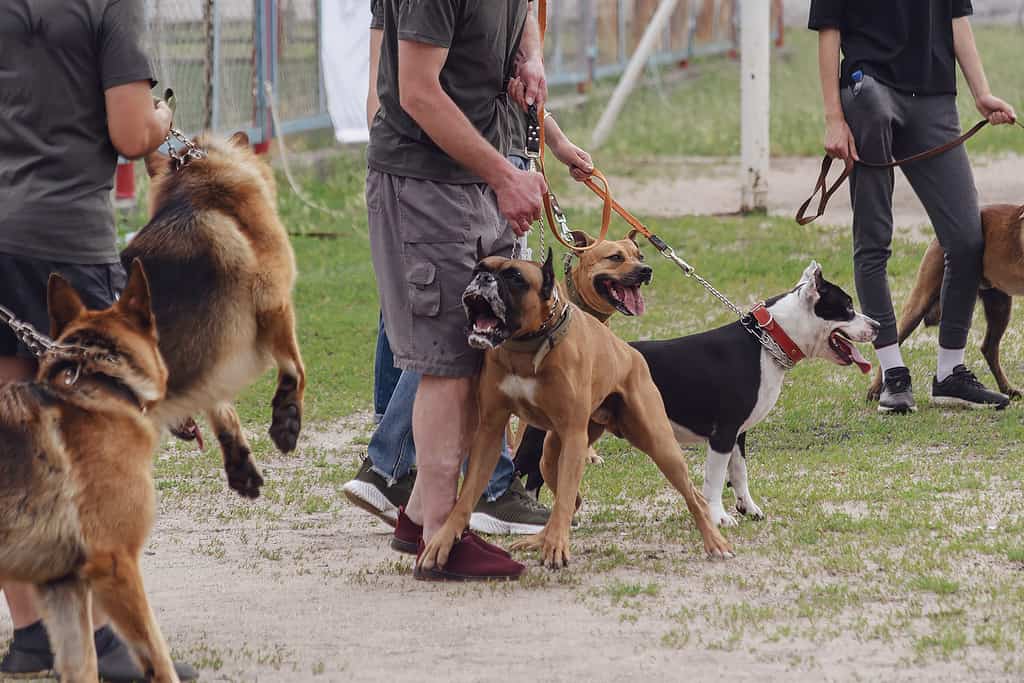
Retractable leashes can present challenges in emergency situations where quick control of your dog is crucial.
©iStock.com/Mikhail Dmitriev
In an emergency, every second counts. Retracting the leash can be time-consuming, especially if there are obstacles or the leash becomes tangled. This delay can compromise your ability to ensure the safety of your dog and others around you.
Retractable leashes can present challenges in emergency situations where quick control of your dog is crucial. When faced with a sudden threat or approaching traffic, the extended length of a retractable leash can impede your ability to respond promptly.
10. Environmental Damage

A retractable leash can get entangled in vegetation or wildlife habitats, leading to damage or disruption of the ecosystem.
©iStock.com/marketlan
Retractable leashes can have unintended consequences for the environment due to the materials they are made of. The thin cord or tape used in these leashes can cause damage to the surroundings. They have the potential to get tangled around plants, trees, or objects, which can result in breakage, littering, or harm to wildlife.
A retractable leash can get entangled in vegetation or wildlife habitats, leading to damage or disruption of the ecosystem. Additionally, when the leash is retracted, it may not be properly controlled, causing it to drag along the ground and potentially disrupt delicate flora or disturb wildlife.
11. Risk Of Injury

Many animals get neck and back injuries because of retractable leashes.
©absolutimages/Shutterstock.com
As mentioned above, using a retractable leash can potentially harm your pet’s neck and throat. When your pet reaches the maximum length of the leash and suddenly stops, it can cause a snap-back effect, which could result in damage to their trachea and neck vertebrae. These injuries can be painful and have long-lasting effects on your pet’s well-being.
Many animals get neck and back injuries because of retractable leashes. These injuries can lead to discomfort and may require extensive treatment and rehabilitation. An injured trachea can cause a persistent cough and, in severe cases, can even affect your pet’s breathing.
It’s important to note that even when keeping the length of a retractable leash short, accidents can still happen, and injuries can occur.
12. Possibility Of Dog Fights
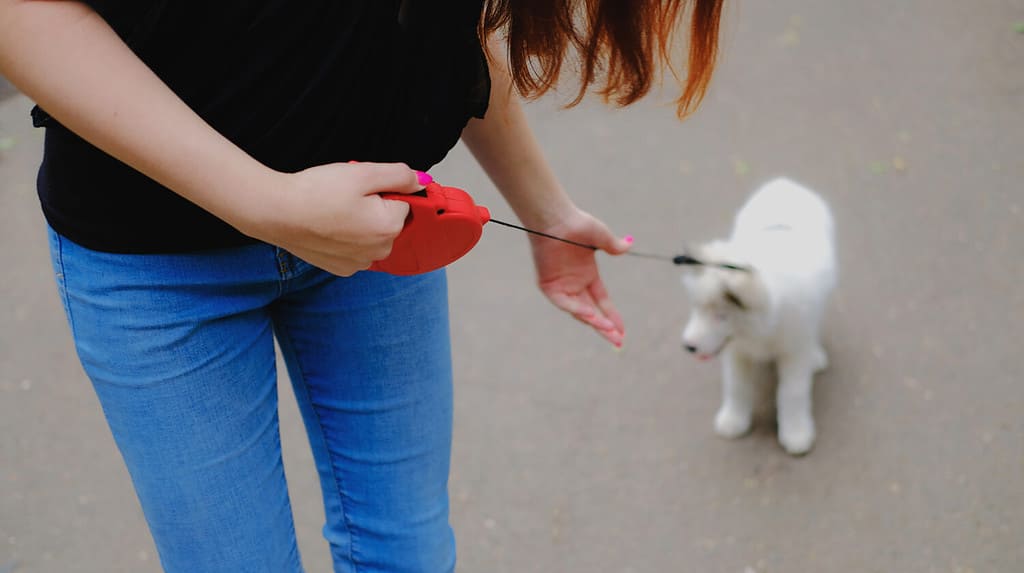
©Yolya Ilyasova/Shutterstock.com
The extended reach of retractable leashes can increase the likelihood of dog fights and confrontations with other pets. These leashes allow your pet to extend far into the personal space of other animals, even if your intention is for your pet to be friendly and social.
It is important to be aware and courteous of the needs of the other dogs around you when you take your dog on a walk. Not all pets you encounter during walks will be friendly or receptive to your pet’s approach. Dogs who are anxious, nervous, or protective may react negatively when another dog invades their personal space. This can result in fearful or aggressive behaviors, escalating into potential dog fights.
The extended range of retractable leashes can also be problematic in dangerous situations. For example, an aggressive dog may approach your pet rapidly, bypassing your ability to retract the leash quickly enough.
13. Locks Can Malfunction

A malfunctioning lock means that the leash may extend or retract unexpectedly, causing your dog to venture too far or suddenly be restrained.
©Javier Brosch/Shutterstock.com
The locks on retractable leashes are not always reliable and can malfunction. If the lock gets stuck at any moment or you accidentally forget to engage it, you could put your dog or someone else in a risky situation.
A malfunctioning lock means that the leash may extend or retract unexpectedly, causing your dog to venture too far or suddenly be restrained. This lack of control can lead to accidents, injuries, or even confrontations with other dogs or people.
14. Drop Noise
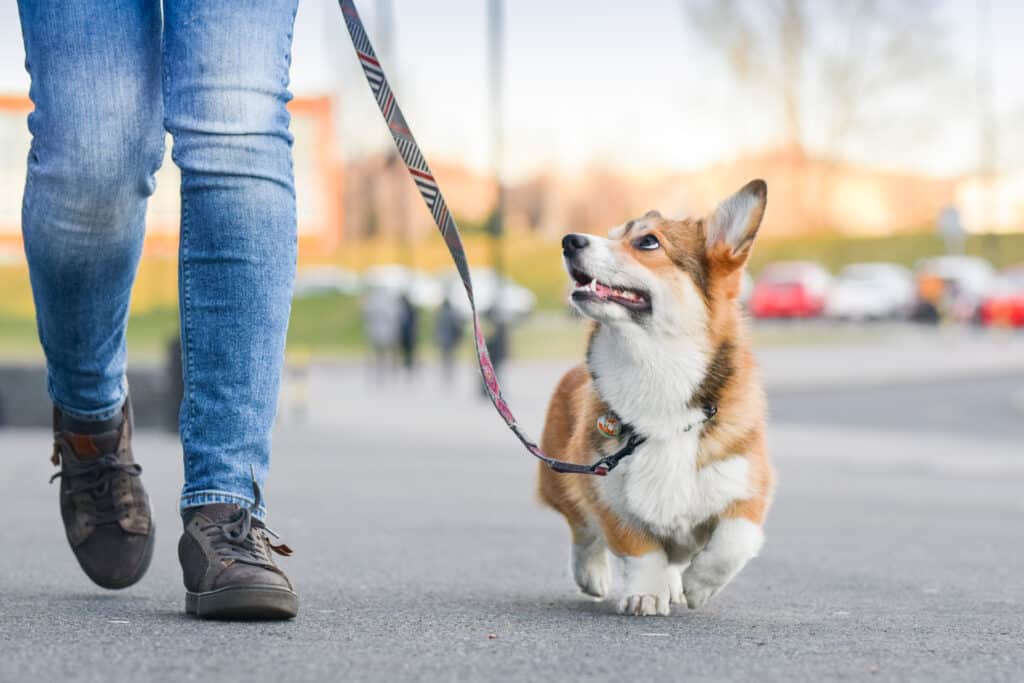
This sudden release of a dropped leash causes a loud noise that startles the dog, potentially leading them to run away in fear.
©Jus_Ol/Shutterstock.com
A common issue with retractable leashes is the possibility of the handle being accidentally dropped or easily pulled out of the walker’s hand when the dog pulls. This sudden release can cause a loud noise that startles the dog, potentially leading them to run away in fear. As the leash handle continues to drag behind them, it creates even more noise, exacerbating their anxiety and encouraging them to keep running.
To avoid this situation, we don’t recommend recommended clipping dog poop bag holders or any additional items to the leash. Doing so can increase the likelihood of the leash handle slipping out of your hand, setting off a chain of events that may result in your dog fleeing.
15. Legal Restrictions
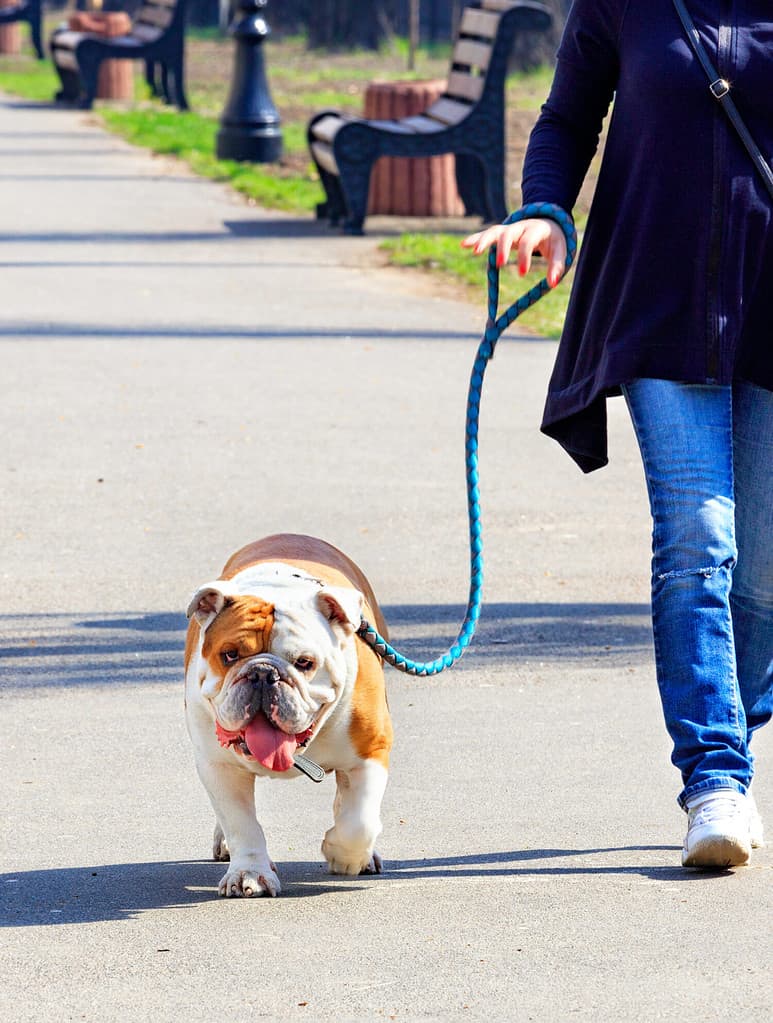
Some regions and municipalities have specific rules, even prohibitions, concerning the use of extendable dog leashes.
©Sergii_Petruk/Shutterstock.com
Even if you ignore all the reasons mentioned above, you can’t ignore the last reason to avoid a retractable leash. Some regions and municipalities have specific rules, even prohibitions, concerning the use of extendable dog leashes. These are usually borne out of a need to keep both pets and people safe.
Typically, these laws don’t explicitly ban retractable leashes but might impose maximum leash lengths. For instance, San Francisco‘s law requires dogs off personal property to be leashed no longer than 8 feet. Take a moment to read up on your local guidelines and ensure a safe, fun, and law-abiding walk with your best friend!
Alternatives to a Retractable Leash For Your Dog
Now that we have discussed the drawbacks of retractable leashes, let’s explore some alternative options that can offer a better experience for both you and your dog.
Rope Leashes
Rope leashes are a sturdy and comfortable option, especially for dogs that might be difficult to control. The material is easy to hold onto and provides sufficient support.
Best rope leash:
- The lockable latch ensures that the leash remains clasped to your dog's collar or harness.
- With a soft, padded handle, this leash is comfortable for dog parents.
- Multiple leash lengths are available, between 5 feet and 150 feet.
- Available for sale are 27 different colors of the same leash.
This is a heavy-duty rope dog leash that is long enough to provide your pet with some freedom, but strong and durable enough to be relatively safe. This is definitely a good alternative to a retractable leash.
Nylon Leashes
These are lightweight yet durable, making them excellent options for smaller, gentler dogs. Nylon leashes can still provide enough control despite their light weight.
Best nylon leash:
- A nylon leash the manufacturer of which promises will last longer than standard cotton leashes.
- The bolt snap swivels to resist twisting.
- This training leash is available in five lengths: 15, 20, 30, 50, or 100 feet.
- 43 styles of this leash are available for sale.
This leash comes in several different lengths and is durable enough to control a small to medium-sized pet. For larger, high-energy dogs, we recommend going for a more sturdy leash.
Leather Leashes
Known for their durability, leather leashes are excellent for strong dogs. They are comfortable to hold while also allowing for corrections when necessary.
Best leather leash:
- A training leash made with genuine Italian leather.
- Copper alloy makes up the clasp, which the manufacturer claims can carry 500 pounds of pull force.
- Four sizes are available, from small to extra large.
- Available in black or brown.
This dog leash is extremely durable and is perfect for large, strong dogs that need a high-quality, heavy-duty lead.
Biothane Line
Ranging from 10 to 50 feet, biothane lines can provide freedom of movement without the tension of a retractable leash. This type of leash is beneficial for dogs with limited recall, allowing them to explore parks or beaches safely.
That said, these leashes still require the owner to actively engage with the line rather than relying on a button to lock or unlock it. This might take some practice, but it can become second nature over time and is a much safer alternative than a retractable leash.
Best biothane line leash:
- A military-grade leash for training dogs.
- The biothane material allows for a secure grip, even in wet conditions.
- Available in multiple lengths, from 3 feet to 33 feet.
- This leash is made in Pennsylvania.
This is an awesome alternative to a retractable leash because it is durable, long enough to give your dog some freedom, and weather resistant. Better yet, this leash is made in the USA!
| Alternative | Why It’s Better |
|---|---|
| Rope Leash | Safer, strong control & easy handling |
| Nylon Leash | Less bulky, lightweight & durable |
| Leather Leash | Comfortable grip, lasting quality & strong control |
| Biothane Line | Long, flexible & safer exploration |
Summary of 15 Reasons to Avoid Retractable Leashes
| Number | Reason |
|---|---|
| 1 | Lack Of Control |
| 2 | Safety Hazards |
| 3 | Lack Of Communication |
| 4 | Retractable Leashes Can Break |
| 5 | Risk of Entanglement |
| 6 | Reinforces Pulling Behavior |
| 7 | Startle Reactions |
| 8 | Limited Training Control |
| 9 | Difficulty In Emergency Situations |
| 10 | Environmental Damage |
| 11 | Risk Of Injury |
| 12 | Possibility Of Dog Fights |
| 13 | Locks Can Malfunction |
| 14 | Drop Noise |
| 15 | Legal Restrictions |
Ready to discover the top 10 cutest dog breeds in the entire world?
How about the fastest dogs, the largest dogs and those that are -- quite frankly -- just the kindest dogs on the planet? Each day, AZ Animals sends out lists just like this to our thousands of email subscribers. And the best part? It's FREE. Join today by entering your email below.
Thank you for reading! Have some feedback for us? Contact the AZ Animals editorial team.











